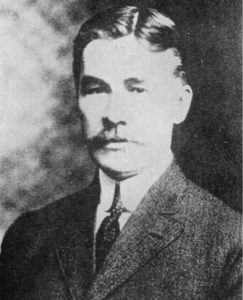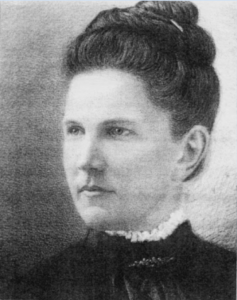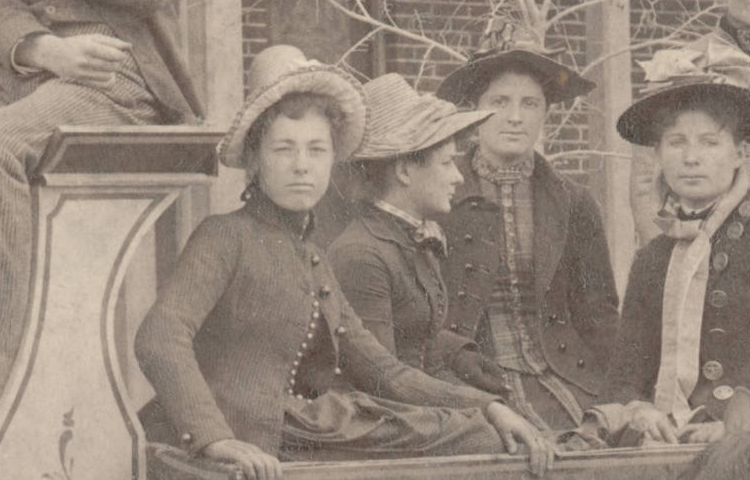Effie June Scott Franklin — A professor of French and German, she was born Aug. 5, 1871, in on a farm in Carlyle Township, Kansas. Her father, Dr. John W. Scott, came to Kansas in 1857, and was active in the free state fight, serving in the first state legislature; Dr. Scott served in the Civil War as surgeon of the Tenth Kansas, and after that war was president of the company that laid out the town of Iola, Kansas.
Effie’s family family moved to the town of Iola, Kansas, in 1874. She graduated from high school in Iola, Kansas, in 1887. She had two older brothers: Angelo C., the eldest; and Charles F. Scott, ten years older than Effie, who represented Kansas for several years as a Republican in the U.S. Congress.
After graduating from high school, Effie taught in the Kansas City, Kansas, schools, and then taught high school in Leavenworth, Kansas. She then began studies at the University of Kansas, receiving her A.B. in 1891. Subsequently she pursued graduate study at Cornell and at the University of Berlin. She was assistant professor of French and German at the University of Kansas for two years until her marriage in 1897; William Carruth was at that time professor of German.
She married Edward Curtis Franklin on July 22, 1897, at Central Presbyterian Church in Denver, Colorado. She and Edward had three children: Anna Comstock (b. Sept., 1898), Charles Scott (b. c. 1902), and John Curtis (b. c. 1905).
Politically, she was a progressive who supported “woman suffrage.”
She was active in the Unitarian church in Lawrence, Kansas, and was a delegate from the Lawrence church to the National Conference of Unitarians in 1911 (the family lived in Washington, D.C., 1911-1913 while Edward worked for the government Hygenic Laboratory).. Prof. William Carruth was also a member of the Lawrence, Kansas, church before he moved to Palo Alto.
Effie moved to Palo Alto in 1903 when her husband accepted a position as professor at Stanford. She was an early member of the Unitarian Church of Palo Alto, and was active in the Women’s Alliance.
When Maria Protsman Scott, Effie’s mother, died in 1907, she was staying with her daughter in Palo Alto; however, it doesn’t appear that Maria was living with the Franklins.
In 1914, a classmate from the University of Kansas visited the Franklins, as well as former Kansans Jennie and Helen Sutliff, and William and Katharine Carruth. She wrote: “At Stanford I spent several days with the Sutliffs and Franklins and had a pleasant visit with Dr. and Mrs. Carruth. … Dr. Franklin was soon to leave for New Zealand where he was going at the request of the British government, in company with fourteen other American scientists of note. Dr. and Mrs. Franklin have a very handsome big daughter Anna, a high school girl, and two younger boys, Charles and Jack.”
Effie was an accomplished pianist, and she was elected an honorary member of the Stanford Music Club in 1916.
She died at her home in Palo Alto on March 31, 1931.
Notes: 1900, 1910 U.S. Census; Graduate Magazine of the University of Kansas, 1931, p. 14; William E. Connolley, History of Kansas Newspapers, Topeka: Kansas State Printing Plant, 1916, p. 47; William E. Connelley, A Standard History of Kansas and Kansans, vol. 3, Chicago: Lewis Pub. Co., 1919, p. 1360; Iola Register, May 30, 1902; Jan Onofrio, Kansas Biographical Dictionary, St. Clair Shores, Miss.: Somerset Pub., 2000, p. 142; The Arrow of Pi Beta Phi, Ann Arbor, Mich.: Michigan Chapter of Beta, October, 1893, p. 118; Iola Register, July 30, 1897, p. 8; John William Leonard, Woman’s Who’s Who of America, 1914-1915, New York: American Commonwealth Co., 1914, p. 305; Christian Register, Oct. 19, 1911, p. 1095; Graduate Magazine of the University of Kansas, March, 1907, p. 224; Graduate Magazine of the University of Kansas, Dec., 1914, p. 91; Stanford Daily, Jan. 25, 1916, p. 2.
 Edward Curtis Franklin — A renowned chemist who grew up in Kansas while it was still part of the frontier, he was born in Geary City, Kansas, on March 1, 1862. He was raised in Doniphan, Kansas, where his father owned a saw mill and grist mill. At the time he was young, that part of Kansas still had the flavor of the frontier, to which some ascribed his later “noticeable impatience with convention.” As a boy, he enjoyed the outdoors, including hunting, fishing, swimming in the Missouri River, and collecting fossils; this love of the outdoors was to remain with him his whole life, and he was an active mountain climber who belonged to the Sierra Club, and summited a number of 14,000 foot peaks. He and his brother William, later a professor at Massachusetts Institute of Technology, made their own batteries, a two-mile long telegraph line, and their own telephone in 1877, only a year after A. G. Bell patented his tel-phone.
Edward Curtis Franklin — A renowned chemist who grew up in Kansas while it was still part of the frontier, he was born in Geary City, Kansas, on March 1, 1862. He was raised in Doniphan, Kansas, where his father owned a saw mill and grist mill. At the time he was young, that part of Kansas still had the flavor of the frontier, to which some ascribed his later “noticeable impatience with convention.” As a boy, he enjoyed the outdoors, including hunting, fishing, swimming in the Missouri River, and collecting fossils; this love of the outdoors was to remain with him his whole life, and he was an active mountain climber who belonged to the Sierra Club, and summited a number of 14,000 foot peaks. He and his brother William, later a professor at Massachusetts Institute of Technology, made their own batteries, a two-mile long telegraph line, and their own telephone in 1877, only a year after A. G. Bell patented his tel-phone.
After he graduated from high school, he worked for a pharmacy in Severance, Kansas, from 1880-1884, then at age 22 entered the University of Kansas. He received his S.B. from the University of Kansas in 1888, studied at the University of Berlin 1890-1891, and received his Ph.D. from Johns Hopkins University in 1894. He was a professor of chemistry at the University of Kansas from 1891 to 1903, and worked for a gold mining company in Costa Rica for a time in 1897. He was professor of chemistry at Stanford from 1903 to his retirement in 1929. As a chemist, he was best known for his work on ammonia and other nitrogen compounds. He was considered an excellent teacher who delivered exceptionally clear lectures.
He married Effie Scott on July 22, 1897, in Denver, Colorado, and they had three children: Anna Comstock (b. Sept., 1898), Charles Scott (b. c. 1902), and John Curtis (b. c. 1905).
He was an early member of the Unitarian Church of Palo Alto. He hosted the monthly social gathering of the Unitarian Church, entertaining “the company with some experiments with liquid air.” Theologically, Unitarianism was a good fit for Franklin: “Even as a youth…Franklin was inclined to be a ‘free thinker’ and agnostic.”
After his wife Effie died in 1931, he lived with his daughter, Anna Franklin Barnett, in Palo Alto. In the last three years of his life, he took long auto-mobile tours of the U.S. and Canada, and died just two months after returning from the last such trip. He died Feb. 13, 1937.
Notes: Alexander Findlay, Journal of the Chemical Society, 1938, p. 583; Howard Elsey, Biographical Memoirs, Nat. Academy of Sciences, 1991, pp. 67-75; Stanford Daily, Feb. 15, 1937, p. 1; Jan Onofrio, Kansas Biographical Dictionary, St. Clair Shores, Miss.: Somerset Pub., 2000, pp. 139 ff.; obituary, Stanford Daily, Feb. 15, 1937; John William Leonard, ed., Men of America: A Biographical Dictionary, New York: L. R. Hamersly & Co., 1908; Pacific Unitarian, April, 1909, p. 186. Photo of Edward from a U.S. Government Web site, ihm.nlm.nih.gov/images/B06647, accessed May 23, 2017.
Anna Comstock Franklin Barnett — A physician and graduate of the Unitarian Church of Palo Alto Sunday school, she was born Sept. 12, 1898, in Lawrence, Kansas, daughter of Effie Scott (q.v.) and Edward Curtis Franklin (q.v.).
Her family moved to Palo Alto in 1903. In 1905, Anna was “one of the first pupils of the Sunday-school” of the Unitarian Church of Palo Alto.
She received her A.B. from Stanford University in 1920, and her M.D. from Stanford in 1924. On July 12, 1924, she married Dr. George de Forest Barnett; he was a physician and professor of medicine at Stanford. They had two children, Margaret A. and Edward F. After the death of her mother in 1931, Anna’s father came to live with her.
Anna joined the faculty of Stanford School of Medicine. Her husband, who had also taught at Stanford School of Medicine, died in 1955. Anna continued to live on campus after her own retirement.
On Oct. 1, 1968, the Stanford Daily reported: “The badly decomposed body of Dr. Anna Barnett, a retired Medical School professor, was discovered in the hills behind Stanford Friday morning. The body was found near Stanford’s antenna farm at 7 a.m. by Eleanore Norris, a resident of Palo Alto, who was strolling in the area near Stanford’s antenna farm. Dr. Barnett, despondent over eye trouble and a scheduled eye operation, disappeared September 13. She left a note indicating she was contemplating suicide. A morphine overdose was determined as the cause of death.” The date of death on the death certificate was Sept. 27, 1968.
Notes: 1900 U.S. Census; Christian Register, Dec. 17, 1925, p. 1236; Stanford University Alumni Directory, 1921, 1931; Stanford Daily, April 30, 1924, p. 1; Stanford Daily, Oct. 1, 1968, p. 4; Carl T. Cox, “Anna Com-stock Franklin,” The Orville, Sutherland, Cox Web site: Ancestors, descendants, and Family Information, oscox.org/cgi-bin/igmget.cgi/n=jucox? I17378, accessed May 25, 2017. (N.B.: Anna’s biography was added an hour or so after Effie’s and Edward’s biographies were posted.)




